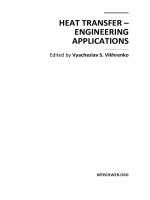Flash Memories Part 1 pot
Bạn đang xem bản rút gọn của tài liệu. Xem và tải ngay bản đầy đủ của tài liệu tại đây (710.62 KB, 20 trang )
FLASHMEMORIES
EditedbyIgorS.Stievano
Flash Memories
Edited by Igor S. Stievano
Published by InTech
Janeza Trdine 9, 51000 Rijeka, Croatia
Copyright © 2011 InTech
All chapters are Open Access articles distributed under the Creative Commons
Non Commercial Share Alike Attribution 3.0 license, which permits to copy,
distribute, transmit, and adapt the work in any medium, so long as the original
work is properly cited. After this work has been published by InTech, authors
have the right to republish it, in whole or part, in any publication of which they
are the author, and to make other personal use of the work. Any republication,
referencing or personal use of the work must explicitly identify the original source.
Statements and opinions expressed in the chapters are these of the individual contributors
and not necessarily those of the editors or publisher. No responsibility is accepted
for the accuracy of information contained in the published articles. The publisher
assumes no responsibility for any damage or injury to persons or property arising out
of the use of any materials, instructions, methods or ideas contained in the book.
Publishing Process Manager Ivana Lorkovic
Technical Editor Teodora Smiljanic
Cover Designer Jan Hyrat
Image Copyright Nadja Antonova, 2010. Used under license from Shutterstock.com
First published August, 2011
Printed in Croatia
A free online edition of this book is available at www.intechopen.com
Additional hard copies can be obtained from
Flash Memories, Edited by Igor S. Stievano
p. cm.
ISBN 978-953-307-272-2
free online editions of InTech
Books and Journals can be found at
www.intechopen.com
Contents
Preface IX
Part 1 Modeling, Algorithms and Programming Techniques 1
Chapter 1 Design Issues and Challenges
of File Systems for Flash Memories 3
Stefano Di Carlo, Michele Fabiano,
Paolo Prinetto and Maurizio Caramia
Chapter 2 Error Control Coding for Flash Memory 31
Haruhiko Kaneko
Chapter 3 Error Correction Codes
and Signal Processing in Flash Memory 57
Xueqiang Wang, Guiqiang Dong,
Liyang Pan and Runde Zhou
Chapter 4 Block Cleaning Process in Flash Memory 83
Amir Rizaan Rahiman and Putra Sumari
Chapter 5 Behavioral Modeling of Flash Memories 95
Igor S. Stievano, Ivan A. Maio and Flavio G. Canavero
Part 2 Applications 111
Chapter 6 Survey of the State-of-the-Art
in Flash-based Sensor Nodes 113
Soledad Escolar Díaz, Jesús Carretero Pérez
and Javier Fernández Muñoz
Chapter 7 Adaptively Reconfigurable
Controller for the Flash Memory 137
Ming Liu, Zhonghai Lu, Wolfgang Kuehn and Axel Jantsch
Chapter 8 Programming Flash Memory
in Freescale S08/S12/CordFire MCUs Family 155
Yihuai Wang and Jin Wu
VI Contents
Part 3 Technology, Materials and Design Issues 175
Chapter 9 Source and Drain Junction Engineering
for Enhanced Non-Volatile Memory Performance 177
Sung-Jin Choi and Yang-Kyu Choi
Chapter 10 Non-Volatile Memory Devices
Based on Chalcogenide Materials 197
Fei Wang
Chapter 11 Radiation Hardness of Flash
and Nanoparticle Memories 211
Emanuele Verrelli and Dimitris Tsoukalas
Chapter 12 Atomistic Simulations of Flash Memory
Materials Based on Chalcogenide Glasses 241
Bin Cai, Binay Prasai and D. A. Drabold
Preface
In recent years, the ICT market has quickly moved toward the integration of a large
variety of functionsinto a single portable electronic equipment. The boundaries
among different devices like music players, digital cameras or mobile phones are
goingtovanish.Inthistrend,oneofthekeyfactorsis
playedbydatastorage,sinceall
these devices require a large amount of memory to store either audio or visualdata.
Also,theenergyconsumptionneedstobereducedtofurtherextend batteryduration
andthefunctionalityofthedevices.
Inthissetting,Flashmemoriesprovideaneffectivesolution, asthey
offer impressive
features, including low noise, reliability, low energy consumption, small size and
weight, and robustness to mechanical stresses. Flash memories are thus actively
contributingtoanewgenerationofdevices.Thetechnologyismatureandthisclassof
devicesismassively usedinawiderange of applications.The performances ofFlash
memoriesalsocontributetothegrowinginterestinsolid‐statedisks,thatarecurrently
replacingtraditionalharddrivesinubiquitousnotebookPCs,netbooksandPCtablets.
The research on memories and their applications, therefore, will be of paramount
importanceforthedevelopmentoffutureelectronicproducts.
This book
is aimed at presenting the state‐of‐the‐art technologies and the research
studies related, but not limited, to flash memories. The book consists of fourteen
Chapters organized into three Parts, which guide the reader through the different
aspectsofthesubject.
Part1focusesonthecontributionsrelatedto
modeling,algorithmsandprogramming
techniques.ThefirstChapterprovidesacomprehensiveoverviewoffilemanagement
with specific interest on native flash file systems. The second and third chapters
address the important problem of error correction and coding. The fourth Chapter
discussesthefeaturesandperformancesofboththeautomaticandthesemi‐automatic
blockcleaningprocesses.Finally,thelastChapterprovidesanoverviewofthestate‐of‐
the‐art methods to build behavioral models of Flash memories for signal and power
integritysimulations.
Part 2 is mainly dedicated to contributions with emphasis on applications. The first
Chapter addresses the problem of
storage in battery‐powered devices operating in a
X Preface
distributed wireless sensor network, thus highlighting the importance of flash
memory chips in a sensor node. The second Chapter presents the design of a
peripheral controller reconfigurable system based on the FPGA Dynamic Partial
Reconfiguration technology, which enables more efficient run‐time resource
management. The last Chapter focuses on practical examples
of in‐circuit
programmingofcommercialflashmemorydevices.
Part 3 collects results on the technology, materials and design topics. The first three
Chapters deal with alternative improved technologies and innovative materials for
enhancingtheperformanceofmemoriesalongwithadetaileddiscussionoffeatures,
strengths and limitations of the
proposed solutions. The las t Chapter concludes the
book by discussingamethod for moleculardynamic simulations.Thissimulation is
aimedatassessingthestrengthsof thesenewmaterialsandtheirpossibleapplication
tothefuturetechnologyofFlashmemories.
Enjoythebook!
IgorSimoneStievano
PolitecnicodiTorino
Dipartimentodi
Elettronica
Italy
Part 1
Modeling, Algorithms
and Programming Techniques
0
Design Issues and Challenges of
File Systems for Flash Memories
Stefano Di Carlo
1
, Michele Fabiano
1
, Paolo Prinetto
1
and Maurizio Caramia
2
1
Department of Control and Computer Engineering, Politecnico di Torino
2
Command Control and Data Handling, Thales Alenia Space
Italy
1. Introduction
The increasing demand for high-speed storage capability both in consumer electronics (e.g.,
USB flash drives, digital cameras, MP3 players, solid state hard-disks, etc.) and mission critical
applications, makes NAND flash memories a rugged, compact alternative to traditional
mass-storage devices such as magnetic hard-disks.
The NAND flash technology guarantees a non-volatile high-density storage support that
is fast, shock-resistant and very power-economic. At higher capacities, however, flash
storage can be much more costly than magnetic disks, and some flash products are still
in short supply. Furthermore, the continuous downscaling allowed by new technologies
introduces serious issues related to yield, reliability, and endurance of these devices (Cooke,
2007; IEEE Standards Department, 1998; Jae-Duk et al., 2002; Jen-Chieh et al., 2002; Ielmini,
2009; Mincheol et al., 2009; Mohammad et al., 2000). Several design dimensions, including
flash memory technology, architecture, file management, dependability enhancement, power
consumption, weight and physical size, must be considered to allow a widespread use of
flash-based devices in the realization of high-capacity mass-storage systems (Caramia et al.,
2009a).
Among the different issues to consider when designing a flash-based mass-storage system, the
file management represents a challenging problem to address. In fact, flash memories store
and access data in a completely different manner if compared to magnetic disks. This must
be considered at the Operating System (OS) level to grant existing applications an efficient
access to the stored information. Two main approaches are pursuit by OS and flash memory
designers: (i) block-device emulation, and (ii) development of native file systems optimized
to operate with flash-based devices (Chang & Kuo, 2004).
Block-device emulation refers to the development of a hardware/software layer able to emulate
the behavior of a traditional block device such as a hard-disk, allowing the OS to communicate
with the flash using the same primitives exploited to communicate with magnetic-disks. The
main advantage of this approach is the possibility of reusing available file systems (e.g., FAT,
NTFS, ext2) to access the information stored in the flash, allowing maximum compatibility
with minimum intervention on the OS. However, traditional file systems do not take into
account the specific peculiarities of the flash memories, and the emulation layer alone may be
not enough to guarantee maximum performance.
1
2 Flash Memory
The alternative to the block-device emulation is to exploit the hardware features of the flash
device in the development of a native flash file system. An end-to-end flash-friendly solution
can be more efficient than stacking a file system designed for the characteristics of magnetic
hard-disks on top of a device driver designed to emulate disks using flash memories (Gal
& Toledo, 2005). For efficiency reasons, this approach is becoming the preferred solution
whenever embedded NAND flash memories are massively exploited.
The literature is rich of strategies involving block-device emulation, while, to the best of
our knowledge, a comprehensive comparison of available native file systems is still missing.
This chapter discusses how to properly address the issues of using NAND flash memories as
mass-memory devices from the native file system standpoint. We hope that the ideas and the
solutions proposed in this chapter will be a valuable starting point for designers of NAND
flash-based mass-memory devices.
2. Flash memory issues and challenges
Although flash memories are a very attractive solution for the development of high-end mass
storage devices, the technology employed in their production process introduces several
reliability challenges (IEEE Standards Department, 1998; Jen-Chieh et al., 2002; Mohammad
et al., 2000). Native flash file systems have to address these problems with proper strategies
and methodologies in order to efficiently manage the flash memory device. Fig. 1 shows a
possible partial taxonomy of such strategies that will be discussed in the sequel of this section.
Fig. 1. A possible taxonomy of the management strategies for flash memories
2.1 Technology
The target memory technology is the first parameter to consider when designing a native flash
file system. The continuous technology downscaling strongly affects the reliability of the flash
memory cells, while the reduction of the distance among cells may lead to several types of cell
interferences (Jae-Duk et al., 2002; Mincheol et al., 2009).
From the technology standpoint, two main families of flash memories do exist: (i) NOR flash
memories and (ii) NAND flash memories. A deep analysis of the technological aspects of
NOR and NAND flash memories is out of the scope of this chapter (the reader may refer to
4
Flash Memories
Design Issues and Challenges of
File Systems for Flash Memories 3
(Ielmini, 2009) for additional information). Both technologies use floating-gate transistors to
realize non-volatile storing cells. However, the NAND technology allows denser layout and
greater storage capacity per unit of area. It is therefore the preferred choice when designing
mass-storage systems, and it will be the only technology considered in this chapter.
NAND flash memories can be further classified based on the number of bit per cell the
memory is able to store. Single Level Cell (SLC) memories store a single bit per cell, while
Multiple Level Cell (MLC) memories allow to store multiple bits per memory cell. Fig.
2 shows a comparison between SLC and MLC NAND flash memories (Lee et al., 2009)
considering three main characteristics: capacity, performance and endurance.
Fig. 2. Comparison of SLC and MLC flash memories
The MLC technology offers higher capacity compared to the SLC technology at the same
cost in terms of area. However, MLC memories are slightly slower than SLC memories.
MLC memories are more complex, cells are closer, there are multiple voltage references
and highly-dependable analog circuitry is requested (Brewer & Gill, 2008). The result is an
increased bit error rate (BER) that reduces the overall endurance and reliability (Mielke et al.,
2008), thus requiring proper error correction mechanisms at the chip and/or file system level.
Consumer electronic products, that continuously demand for increased storage capacity, are
nowadays mainly based on MLC NAND flash memories, while mission-critical applications
that require high reliability mainly adopt SLC memories (Yuan, 2008).
2.2 Architecture
A native flash file system must be deeply coupled with the hardware architecture of the
underlying flash memory. A NAND flash memory is usually a hierarchical structure
organized into pages, blocks and planes.
A page groups a fixed number of memory cells. It is the smallest storage unit when
performing read and programming operations. Each page includes a data area where actual
data are stored and a spare area. The spare area is typically used for system level management,
although there is no physical difference from the rest of the page. Pages already written with
data must be erased prior to write new values. A typical page size can be 2KB plus 64B
spare, but the actual trend is to increase the page size up to 4KB+128B and to exploit the MLC
technology.
A block is a set of pages. It is the smallest unit when performing erase operations. Therefore, a
page can be erased only if its corresponding block is totally erased. A block typically contains
64 pages, with a trend to increase this number to 128 pages per block, or even more. Since flash
5
Design Issues and Challenges of File Systems for Flash Memories
4 Flash Memory
memories wear out after a certain number of erasure cycles (endurance), if the erasure cycles
of a block exceed this number, the block cannot be considered anymore reliable for storing
data. A typical value for the endurance of an SLC flash memory is about 10
5
erasure cycles.
Finally, blocks are grouped into planes. A flash memory with N planes can read/write and
erase N pages/blocks at the same time (Cooke, 2007).
#
!$
!%"
!$"! !$"!
Fig. 3. A Dual Plane 2KB-Page SLC NAND Flash memory
Fig. 3 shows an example of a 512MB dual plane SLC NAND flash memory architecture
proposed in (Cooke, 2007). Each plane can store 256MB with pages of 2KB+64B. A data
register able to store a full page is provided for each plane, and an 8-bit data bus (i.e., I/O
0-7) is used to access stored information.
Several variations of this basic architecture can be produced, with main differences in
performance, timing and available set of commands (Cooke, 2007). To allow interoperability
among different producers, the Open NAND Flash Interface (ONFI) Workgroup is trying to
provide an open specification (ONFI specification) to be used as a reference for future designs
(ONFI, 2010).
2.3 Address translation and boot time
Each page of a flash is identified by both a logical and physical address. Logical addresses
are provided to the user to identify a given data with a single address, regardless if the
actual information is moved to different physical locations to optimize the use of the device.
The address translation mechanism that maps logical addresses to the corresponding physical
addresses must be efficient to generate a minor impact on the performance of the memory. The
address translation information must be stored in the non-volatile memory to guarantee the
integrity of the system. However, since frequent updates are performed, a translation lookup
table is usually stored in a (battery-backed) RAM, while the flash memory stores the metadata
to build this table. The size of the table is a trade-off between the high cost of the RAM and
the performance of the storage system.
Memories with a large page size require less RAM, but they inefficiently handle small writes.
In fact, since an entire page must be written into the flash with every flush, larger pages cause
more unmodified data to be written for every (small) change. Small page sizes efficiently
handles small writes, but the resulting RAM requirements can be unaffordable. At the file
system level, the translation table can be implemented both at the level of pages or blocks
thus allowing to trade-off between the table size and the granularity of the table.
6
Flash Memories
Design Issues and Challenges of
File Systems for Flash Memories 5
2.4 Garbage collection
Data stored in a page of a flash memory cannot be overwritten unless an erasure of the full
block is performed. To overcome this problem, when the content of a page must be updated,
the new data are usually saved in a new free page. The new page is marked as valid while
the old page is marked as invalid. The address translation table is then updated to allow the
user to access the new data with the same logical address. This process introduces several
challenges at the file system level.
At a certain point, free space is going to run out. When the amount of free blocks is less than
a given threshold, invalidated pages must be erased in order to free some space. The only
way to erase a page is to erase the whole block it belongs to. However, a block selected for
erasure may contain both valid and invalid pages. As a consequence, the valid pages of the
block must be copied into other free pages. The old pages can be then marked as invalid and
the selected block can be erased and made available for storage.
This cleaning activity is referred to as garbage collection. Garbage collection decreases the flash
memory performance and therefore represents a critical aspect of the design of a native flash
file system. Moreover, as described in the next subsection, it may impact on the endurance of
the device. The key objective of an efficient garbage collection strategy is to reduce garbage
collection costs and evenly erase all blocks.
2.5 Memory wearing
As previously introduced, flash memories wear out after a certain number of erasure cycles
(usually between 10
4
and 10
5
cycles). If the number of erasures of a block exceeds this number,
the block is marked as a bad block since it cannot be considered anymore reliable for storing
data. The overall life time of a flash memory therefore depends on the number of performed
erasure cycles. Wear leveling techniques are used to distribute data evenly across each block of
the entire flash memory, trying to level and to minimize the number of erasure cycles of each
block.
There are two main wear leveling strategies: dynamic and static wear leveling. The dynamic
wear leveling only works on those data blocks that are going to be written, while the static
wear leveling works on all data blocks, including those that are not involved in a write
operation. Active data blocks are in general wear-leveled dynamically, while static blocks
(i.e., blocks where data are written and remain unchanged for long periods of time) are
wear-leveled statically. The dynamic and static blocks are usually referred as hot and cold
data, respectively. In MLC memories it is important to move cold data to optimize the wear
leveling. If cold data are not moved then the related pages are seldom written and the wear
is heavily skewed to other pages. Moreover, every read to a page has the potential to disturb
data on other pages in the same block. Thus continuous read-only access to an area can cause
corruption, and cold data should be periodically rewritten.
Wear leveling techniques must be strongly coupled with garbage collection algorithms at the
file system level. In fact, the two tasks have in general conflicting objectives and the good
trade-off must be found to guarantee both performance and endurance.
2.6 Bad block management
As discussed in the previous sections, when a block exceeds the maximum number of erasure
cycles, it is marked as a bad block. Bad blocks can be detected also in new devices as a result of
blocks identified as faulty during the end of production test.
7
Design Issues and Challenges of File Systems for Flash Memories
6 Flash Memory
Bad blocks must be detected and excluded from the active memory space. In general, simple
techniques to handle bad blocks are commonly implemented. An example is provided by
the Samsung’s XSR (Flash Driver) and its Bad Block Management scheme (Samsung, 2007).
The flash memory is initially split into a reserved and a user area. The reserved blocks in the
reserved area represent a Reserve Block Pool that can be used to replace bad blocks. Samsung’s
XSR basically remaps a bad block to one of the reserved blocks so that the data contained in a
bad block is not lost and the bad block is not longer used.
2.7 Error correcting codes
Fault tolerance mechanisms and in particular Error Correcting Codes (ECCs) are
systematically applied to NAND flash devices to improve their level of reliability. ECCs are
cost-efficient and allow detecting or even correcting a certain number of errors.
ECCs have to be fast and efficient at the same time. Several ECC schema have been proposed
based on linear codes like Hamming codes or Reed-Solomon codes (Chen et al., 2008; Micron,
2007). Among the possible solutions, Bose-Chaudhuri-Hocquenghem (BCH) codes are linear
codes widely adopted with flash memories (Choi et al., 2010; Junho & Wonyong, 2009;
Micheloni et al., 2008). They are less complex than other ECC, providing also a higher
code efficiency. Moreover, manufacturers’ and independent studies (Deal, 2009; Duann, 2009;
Yaakobi et al., 2009) have shown that flash memories tend to manifest non-correlated bit
errors. BCH are particularly efficient when errors are randomly distributed, thus representing
a suitable solution for flash memories.
The choice of the characteristics of the ECC is a trade-off between reliability requirements and
code complexity, and strongly depends on the target application (e.g. consumer electronics vs
mission-critical applications) (Caramia et al., 2009b).
ECC can be implemented both at the software-level, or resorting to hardware facilities.
Software implemented ECC allow to decouple the error correction mechanisms from the
specific hardware device. However, the price to pay for a software-based ECC solution is
a drastic performance reduction. For this reason, available file systems tend to delegate the
code computation tasks to a dedicate hardware limiting the amount of operations performed
in software, at the cost of additional resources (e.g., hardware, power consumption, etc.) and
reduced flexibility.
3. File systems for flash memories
As shortly described in the introduction of this chapter, at the OS level the common
alternatives to manage flash based mass-storage devices are block-device emulation and
native flash file systems (Chang & Kuo, 2004). Both approaches try to address the issues
discussed in Section 2. Fig. 4 shows how the two solutions can be mapped in a generic OS.
The block-device emulation approach hides the presence of a flash memory device, by
emulating the behavior of a traditional magnetic hard-disk. The flash device is seen as a
contiguous array of storage blocks. This emulation mechanism is achieved by inserting at the
OS level a new layer, referred to as Flash Translation Layer (FTL). Different implementations of
FTL have been proposed (Chang et al., 2007; Intel, 1998; Jen-Wei et al., 2008). The advantage
of using an FTL is that existing file systems, such as NTFS, Ext2 and FAT, usually supported
by the majority of modern OS, can be directly used to store information in the flash. However,
this approach has many performance restrictions. In fact, existing file systems do not take
into account the critical issues imposed by the flash technology (see Section 2) and in several
situations they may behave in contrast with these constraints. Very sophisticated FTL must
8
Flash Memories









